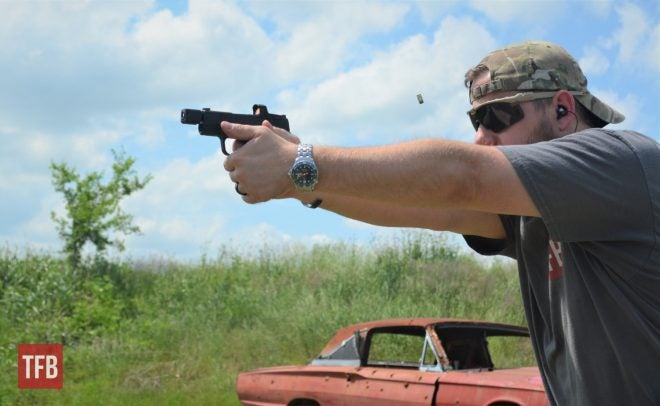Springfield Armory is a storied name. Its lineage stretches back to America’s early days, more than two centuries before the genesis of today’s Hellcat pistol. The original version of Springfield Armory was a military weapons storage facility in Massachusetts, ordered by George Washington in 1777. In 1795, they added arms production capability for the fledgling nation’s armed forces, and this practice continued for 173 years. After the facility ceased operations in 1968 and was subsequently declared a National Historic Site, a small gunmaker in Texas began using the name to take advantage of its notoriety. In 1974, the L. H. Gun Company officially became Springfield Armory, Inc. and moved to Illinois. Though the name is the only thing they substantively share in common, the modern private company gives a nod to the historic military armory’s legacy by wearing it.
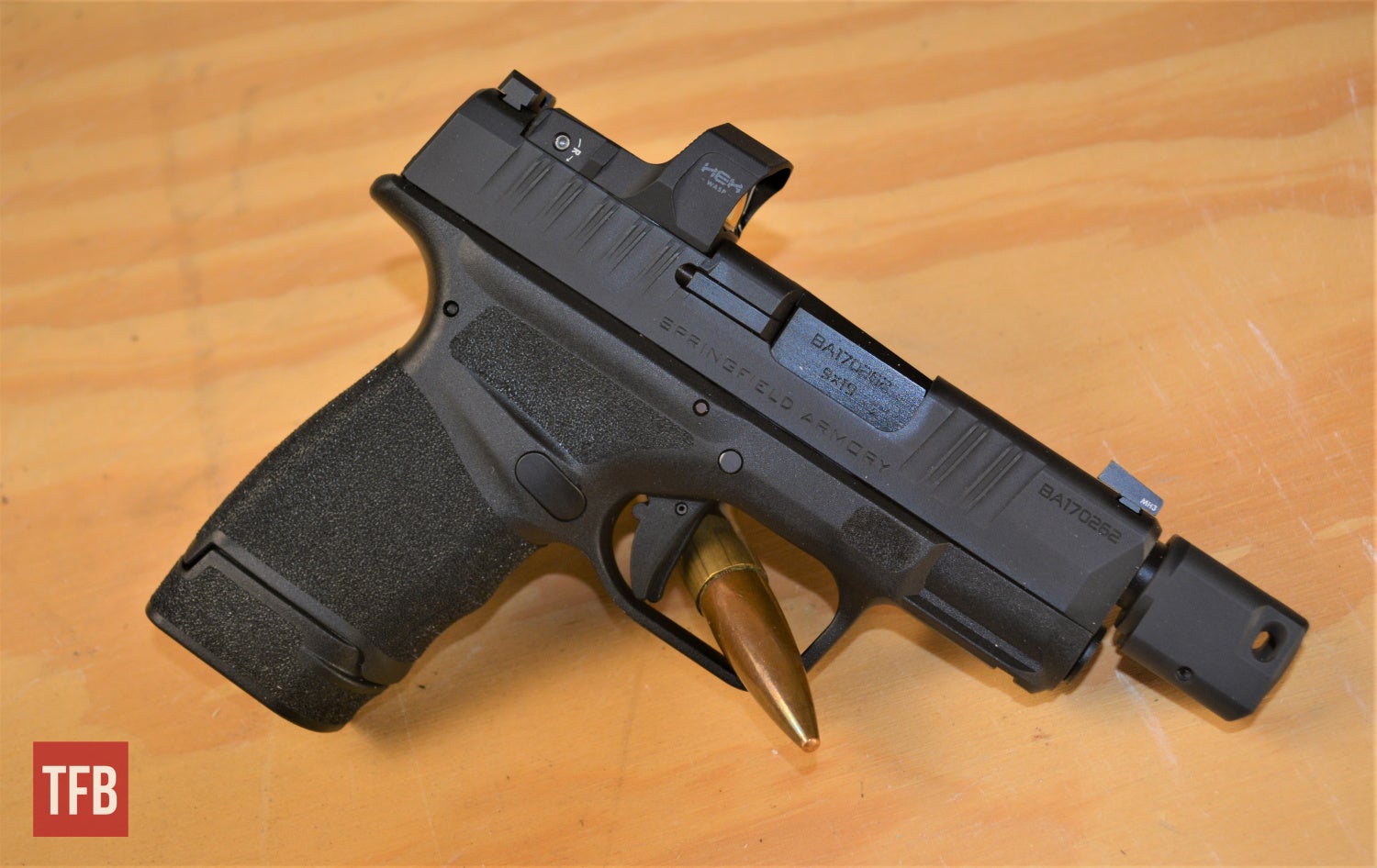
RDP stands for “Rapid Defense Package”, and this version of the Hellcat comes as a full kit including the red dot and compensator as shown here.
The Springfield Hellcat @ TFB:
- Springfield Armory Hellcat Rapid Defense Package (RDP)
- Gimmick or Good to Go? Springfield Hellcat RDP Review
- Springfield Armory’s New 15-Round Hellcat Magazines
- 20K Round Endurance Test Accomplished for the Springfield Hellcat 9mm
- TFB Review: Springfield Armory Hellcat 9mm – World’s Highest Capacity Micro Compact
- Springfield Armory Hellcat: World’s Highest Capacity Micro-Compact 9mm
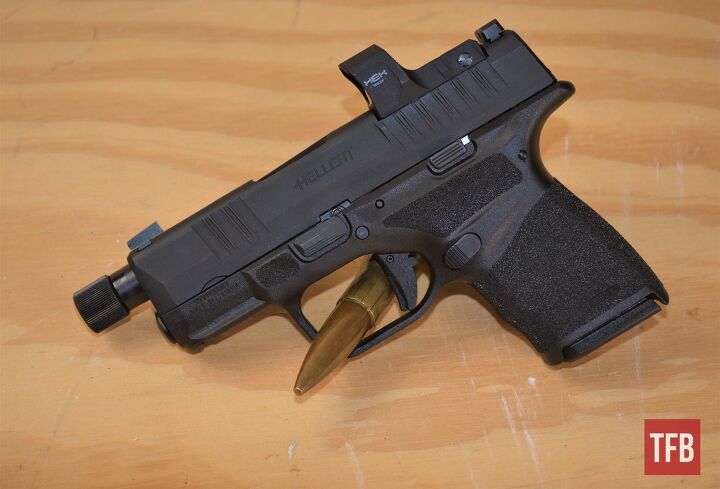
The compensator features an excellent self-timing design that allows for quick threading on or off, so you can easily switch to the uncompensated configuration shown here.
Today, Springfield sells several lines of rifles and pistols. Just before SHOT Show 2020, they announced a new handgun model: the Hellcat. For this micro-compact’s design and production, Springfield returned to their friends in Croatia, HS Produkt, with whom they’d previously partnered on the XD series. Shipping these diminutive guns with a 13-round magazine and an 11-rounder, Springfield advertised their newest pistol as “The highest capacity micro-compact 9mm in the world.” The Hellcat’s size is comparable to SIG SAUER’s P365 or the Glock 26, and both of those handguns use 10-rounders as their standard, baseline mags. However, it’s not uncommon for shooters of these models to employ optional extended 12 or 15-round magazines, so the “highest capacity” claim can fairly be taken with a grain of salt. That said, keeping a 13+1 9mm capacity contained in just 4.5″ of height by 1″ wide is a solid offering, and the market took note. The original Hellcat was generally well received, and has sold its fair share of units. Our own Adam Scepaniak loves it, and it’s garnered some awards from around the industry.
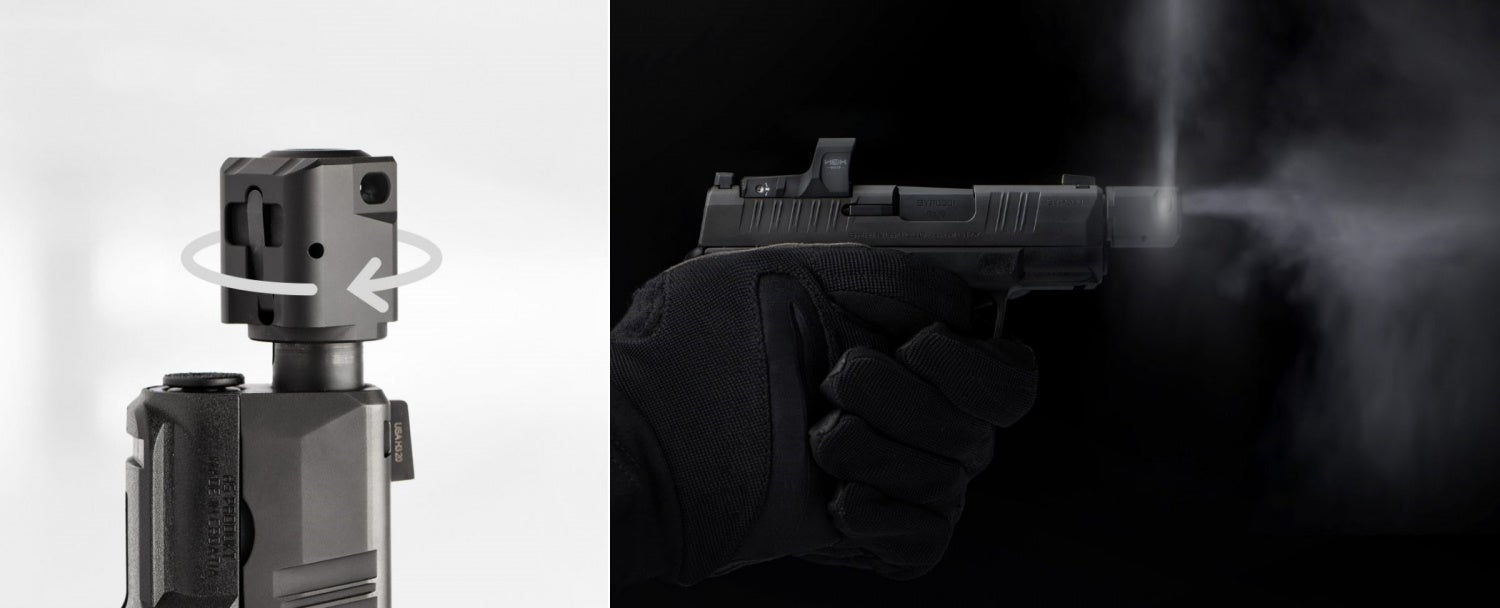
While the pros and cons of comping a subcompact CCW are debatable, the easy on/off mechanism of this muzzle device is one of the gun’s high points for me.
For my part, although I didn’t hate it, I found myself a bit less enamored with the first-gen Hellcat than my friend Adam was. I thought it wasn’t bad, and seemed to do a decent job accomplishing what it set out to, but not any better than (or in some cases even quite as well as) its competitors. I could see why some shooters would want to own one, but I wasn’t one of them. I didn’t personally prefer some of its particulars like the trigger or ergonomics. To be fair: my personal Hellcat testing was not extensive, with fewer than 100 rounds fired. But that was enough for me to basically say, “Okay, I get it, that’s fine.” and be ready to put it away. Fast forward to early 2021, when Springfield announced a new version. The RDP model, or Rapid Defense Package (not Red Dot Pistol, as I’ve seen bandied about social media), features two immediately obvious changes from the original. It comes out of the box with the addition of a factory optic and compensator, following recent trends in the handgun market’s aftermarket upgrade department which have begun making their way into some manufacturer’s default offerings.
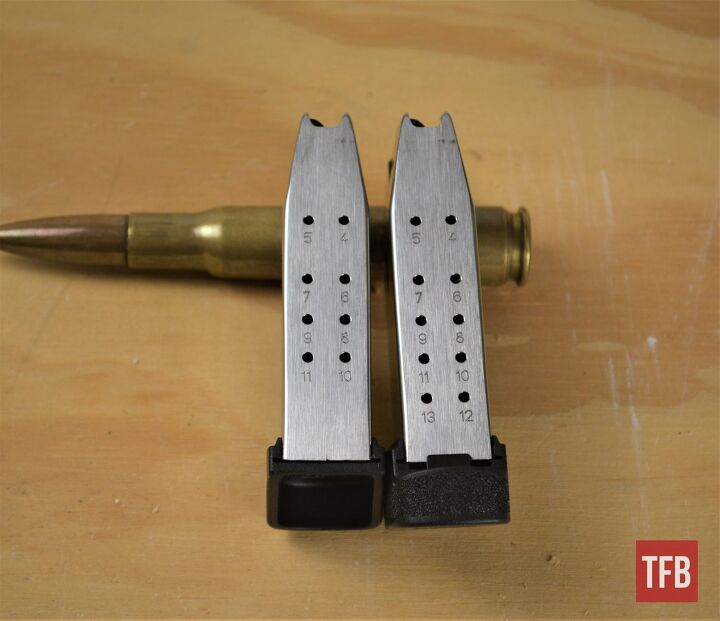
Included in the box you get one 11-round 9mm magazine and one 13-rounder.
It’s become clear (I believe) that pistol optics are likely here to stay, so plenty of companies now offer their guns with optional – or even standard – slides that come pre-cut to accept small red dots. From Glocks to H&Ks to SIGs and more, it’s become increasingly common for pistol shooters to treat their iron sights as backups, in much the same fashion as many ARs have come to be configured. Springfield is listening to their customers on this, and has come to offer Hellcats with optics-ready slides as well as a model that comes pre-loaded with an SMSc, or Shield Mini Sight compact. Now with the RDP, they’ve doubled down on the dots, with the inclusion of an optic from their brand-new very own in-house optics brand, Hex Optics.
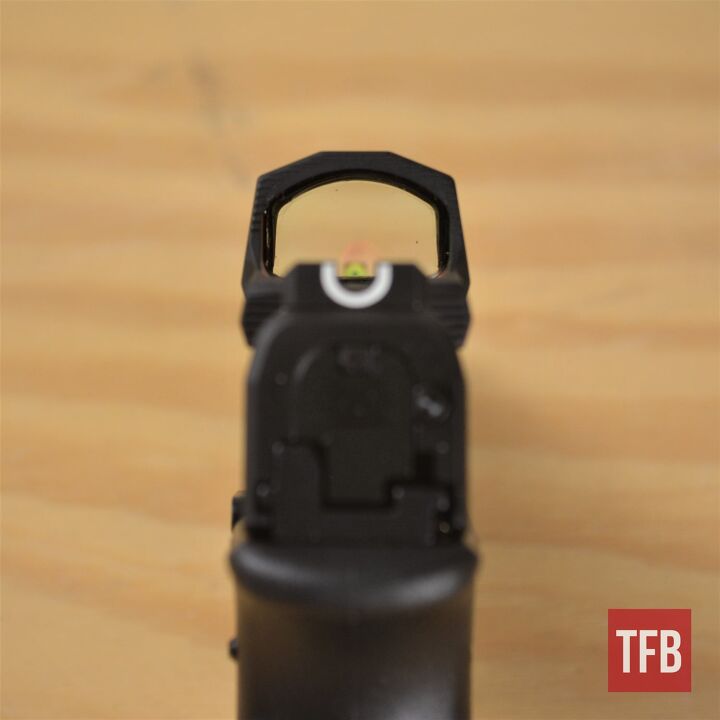
Though its auto-brightness function leaves something to be desired, the Hex Wasp optic’s physical design and construction gave good impressions.
Hex Optics just launched in February, after more than two years in development under Springfield’s umbrella. They’ve come out of the gate with two models: a standard-sized pistol red dot, the Dragonfly, and its little brother, the Wasp. With the Hellcat being a micro-compact gun, the Wasp is the optic that fits and comes mounted on it. If purchased alone, the Wasp carries a $299 MSRP. Suited for smaller handguns, this .95″ wide 3.5 MOA red dot utilizes the Shield RMSc footprint, and boasts approximately 2 years of real-world battery life from a CR2032. Its 6061 T6 aluminum housing features some well thought-out geometry, including an integrated rear iron sight, slight protrusions on the sides to aid in racking your slide with a pinch-style grip, and an extended forward lens shroud meant to protect the glass from impact or if you had to rack the slide directly on the optic, say for example one-handed on a tabletop.
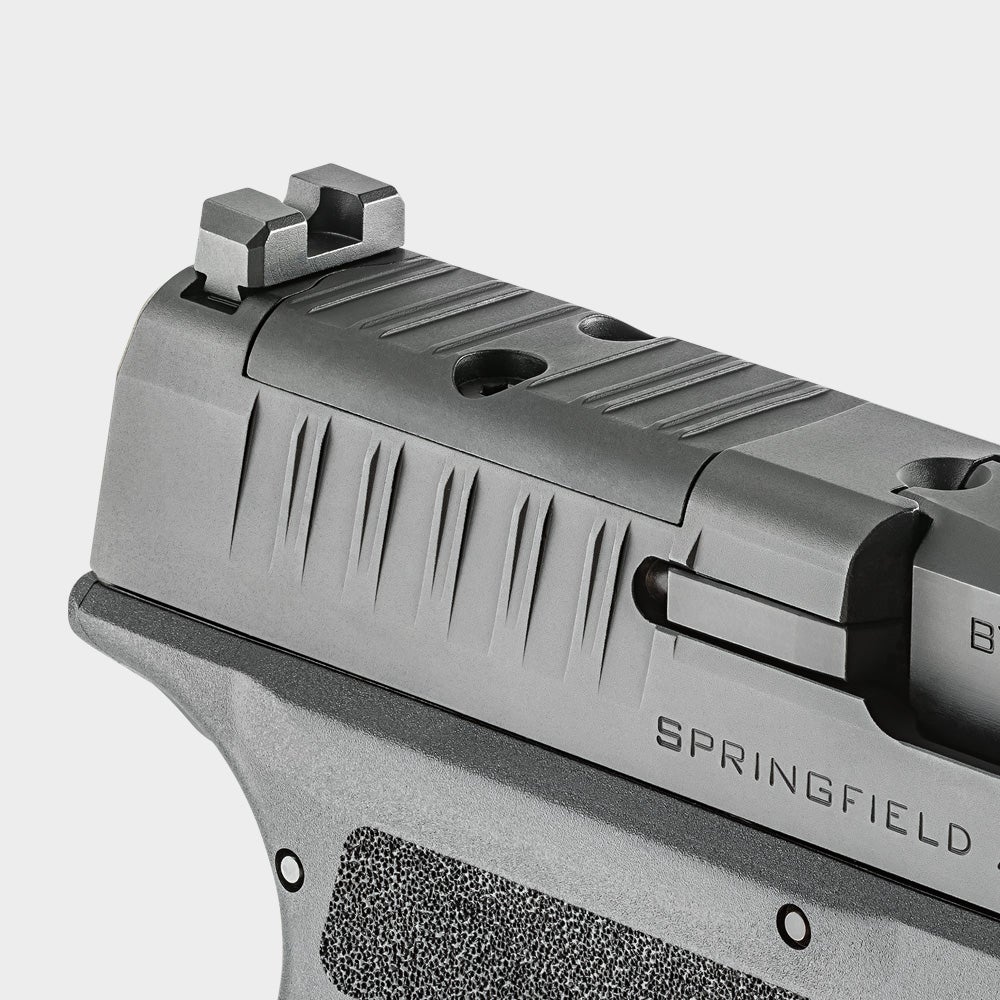
Springfield includes a slide cover plate, in case you opt to remove the installed MRDS and just run iron sights instead.
Although the window is a bit squat compared to some other pistol optics, it wasn’t unmanageably so. The dot is always on, but has an auto-dimming sensor meant to automatically adjust your brightness to ambient lighting conditions. There are no buttons on the unit, and no brightness adjustability. Unfortunately, I found this to be an issue when sighting between significantly disparate lighting conditions. The Hex optic can have trouble adjusting from a darker area to a brighter one, so it takes a few beats for the reticle to catch up in case of photonic barriers. Manual brightness could help, but with the Wasp, you only get whatever it thinks you need. While that’s okay most of the time, it can be suboptimal. All else being equal, I’d probably pick a Holosun 507k or Trijicon RMRcc instead. Be sure you like the Hex optic before purchasing a Hellcat RDP equipped with one. I highly recommend an in-person test rather than ordering sight unseen, just to be safe.
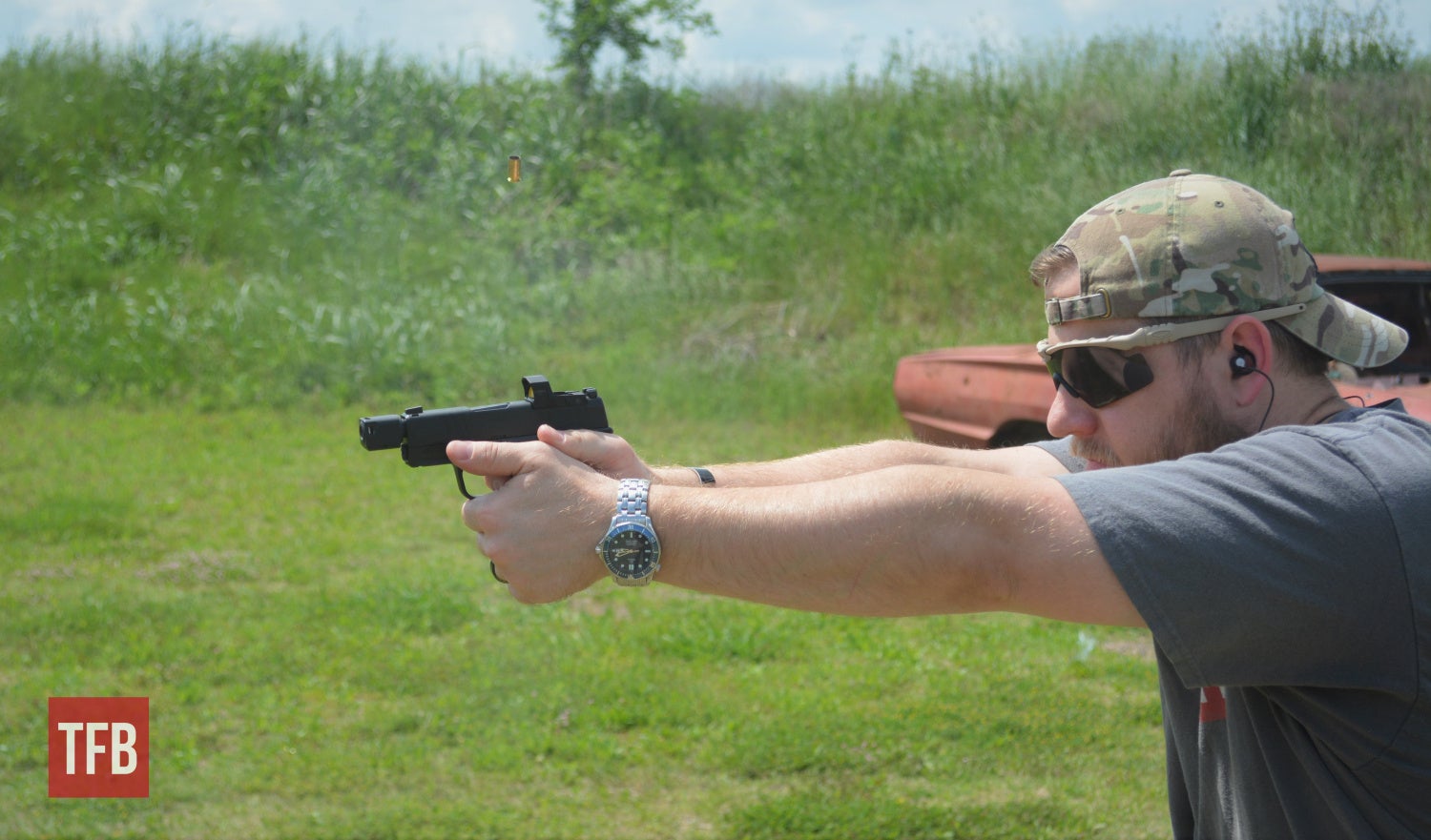
The compensator adds approximately one extra inch of length, and the Wasp sits slightly under an inch tall.
Although the Wasp is a bit hit-and-miss, I’ll absolutely give credit where due – and credit is due for the RDP’s compensator. I’ve installed other comps before, and this self-indexing design is a clear improvement. Many other comps on the market require shims, timing, set screws, o-rings, Rocksett, and/or Loctite, depending on the make and model. They can be finicky to install and require permanent or near-permanent affixing to your barrel. Springfield’s comp does away with all that thanks to its excellently designed self-timing function. It manages to provide quick and easy installation/uninstallation while staying rock-solid. This makes it a breeze to disassemble, clean and maintain, or swap between the muzzle brake and a suppressor. No other comp I’ve used accomplishes this nearly as well (or at all). While I’m not generally a fan of running comps on CCWs, if you’re going to, this self-indexing device is a great way to do it.

In case you’re like me and don’t prefer the Hex red dot, Springfield sells Hellcat RDPs that come with a Shield SMSc optic installed instead.
One of my main concerns with any pistol in this size category will always be shootability. Subcompact pistols prioritize concealment, and in my experience, this usually comes at the price of some added snappiness compared to their bigger brothers. I tend to like carrying a compact-class gun for this reason. Ideally, the addition of the RDP’s compensator might help smooth a bit of that muzzle flip inherent with the gun’s short barrel and low mass. I test fired this Hellcat both with and without the comp installed, hoping this would be the case. In my experience, with a suitably solid grip, the leveling benefits were minimal. Although for some there may be marginal gains in feel, I never sensed a major difference and didn’t get any notable change in accuracy or speed. However, the way you grip and manipulate a pocket pistol may garner more benefit from the comp than I saw, so I’d encourage you to test for yourself. Ultimately, performance fell in line with my expectations. The Hellcat RDP was approximately the same for me in terms of live-fire performance as its base-model predecessor: passable. It’s a bit more concealable but less nice to shoot than pistols that are a size up, and broadly on par with other guns its same size. Whether that makes sense for you is a matter of shooter preference.
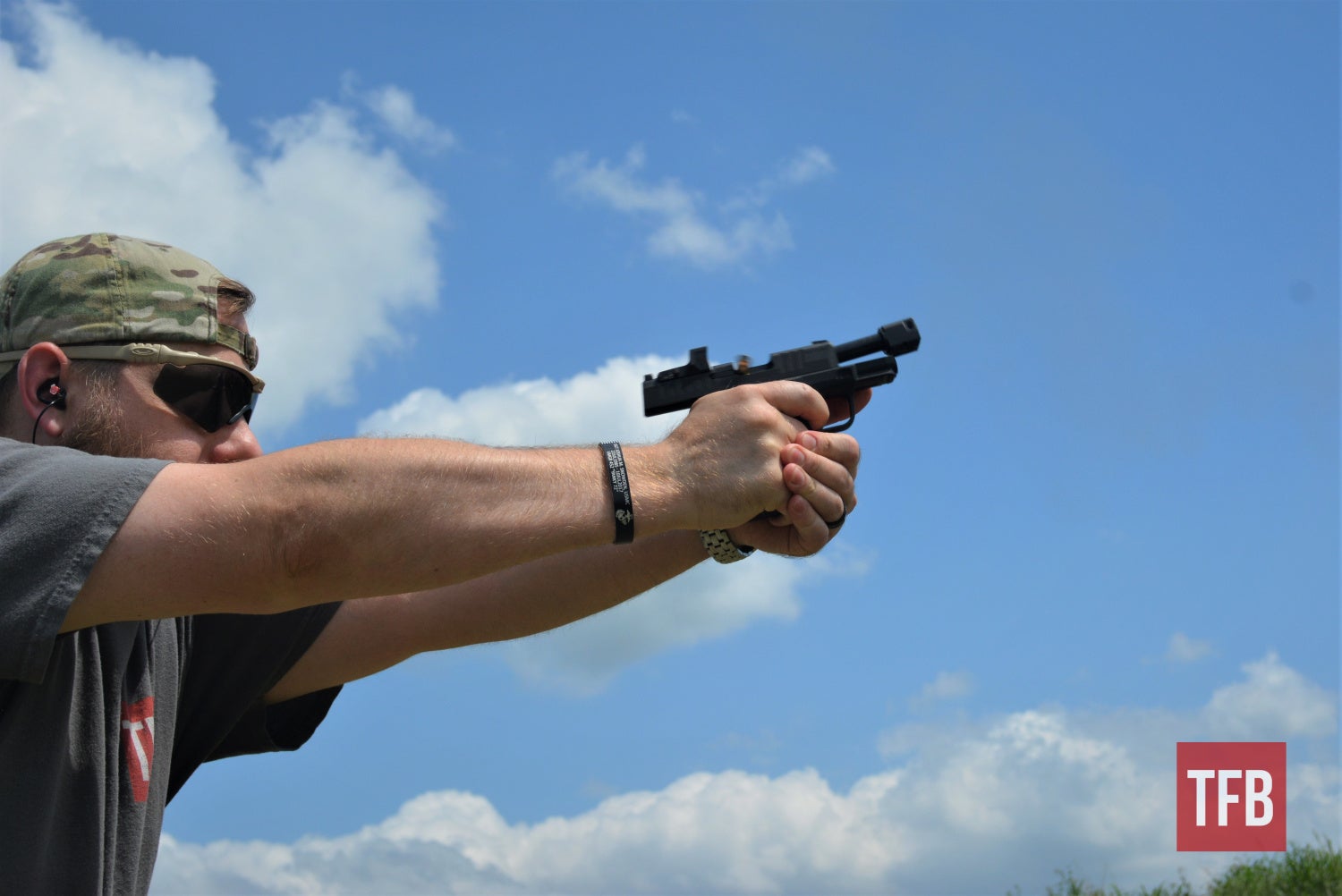
The RDP carries an MSRP of $899, which is an increase of $289-$330 over the Hellcat models that don’t come with an optic or comp. Whether it’s worth that premium depends heavily on how well you like those two specific components.
The big question: is it a “buy”? For me, no. After spending a good bit of time with one, I can’t honestly say that I’m itching to add a Hellcat RDP to my collection. The overarching sense I got with the RDP was similar to the original Hellcat: “not bad”. The draw of the included optic and comp aren’t enough to sell me at an $899 MSRP. If I was going to buy a Hellcat, I’d likely skip the comp and pick the OSP model, adding an optic that I like better than the Hex. And beyond that, I’m not sure I’d pick any Hellcat model over a different “pocket rocket” like the Glock 43x MOS or SIG P365X. I simply prefer the way some other comparable guns shoot and feel/fit. However, that’s just it: “prefer” is the operative term. There’s been nothing in my experience with this gun to indicate that it’s objectively deficient or functionally lacking when compared to other subcompacts. It cycled flawlessly and reasonably accomplishes what it intends.
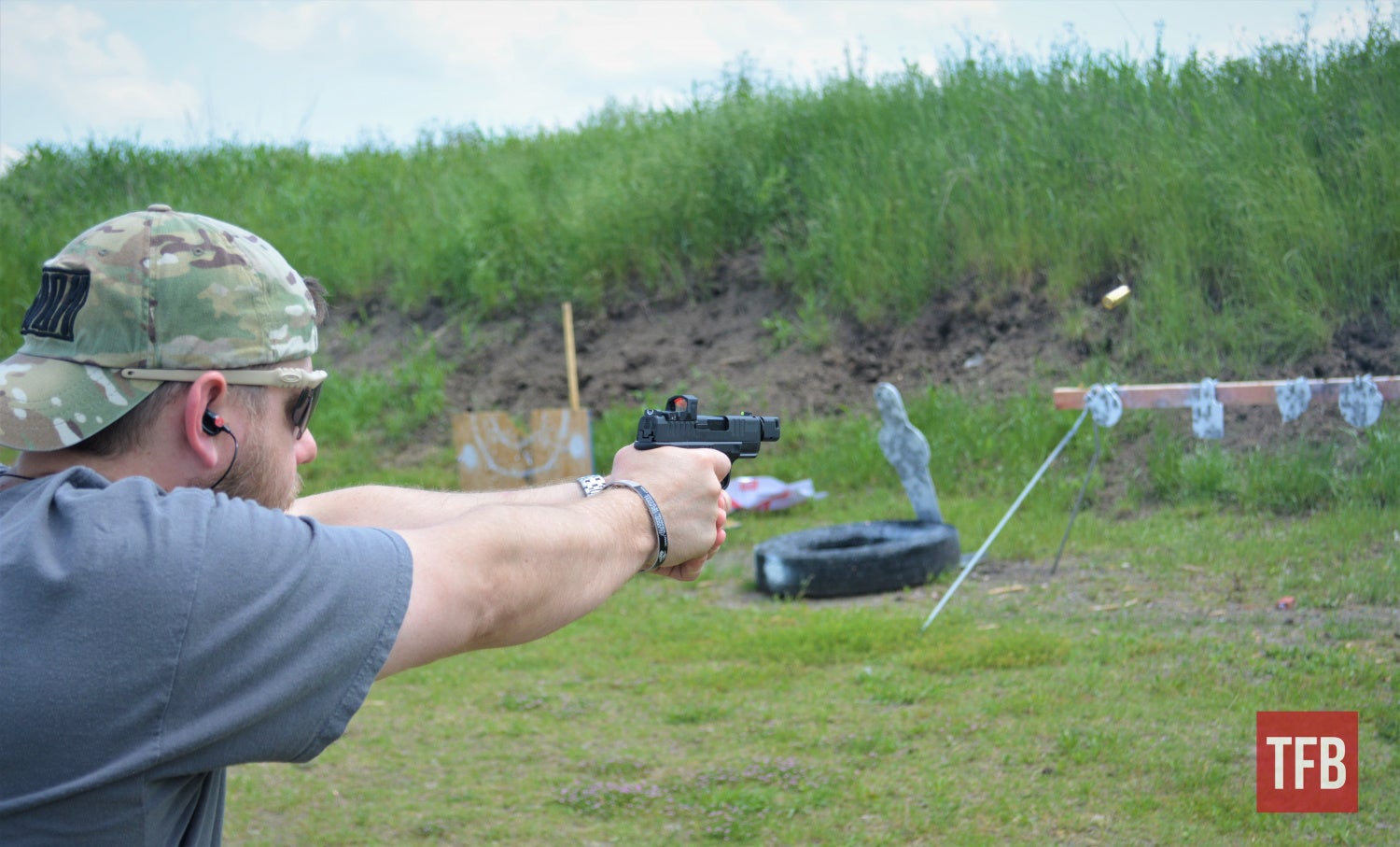
While my personal preference in the subcompact space tends more toward SIG’s P365X or Glock’s 43X MOS, plenty of buyers will like the Hellcat RDP – and there’s definitely a valid case for those in that camp.
So, while I’m not a Hellcat RDP buyer, you may be. There’s definitely a market for this kind of package, and I’m confident that Springfield will sell their fair share. I have no qualms about recommending that you consider this gun, if you find yourself in that niche of wanting a one-stop-shop solution for a comped and red-dotted micro handgun. Should you be one of those buyers for whom it ticks the boxes on paper, there’s every potentiality that the Hellcat may suit you better than they did me. If so, I believe you can be confident in the operational aspects of the gun. It’s small enough to conceal well, but still provides strong magazine capacity for the class, and at least in the low-count testing I was able to perform, it worked sufficiently well. Though it may not be quite enough to supplant its competitors in the subcompact realm, the Springfield Hellcat RDP still warrants a place among them and in your consideration set. See you at the range!
Images courtesy of Springfield Armory and the author.
We are committed to finding, researching, and recommending the best products. We earn commissions from purchases you make using the retail links in our product reviews. Learn more about how this works.
 Your Privacy Choices
Your Privacy Choices
